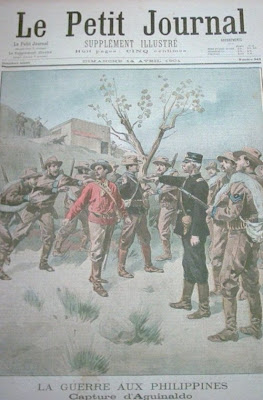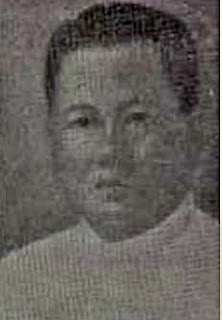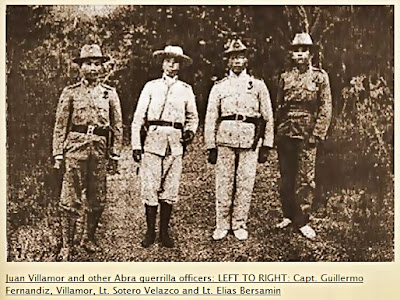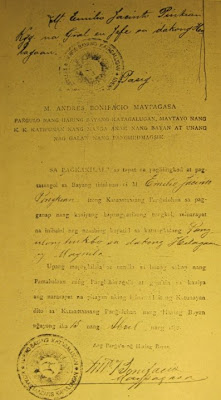 |
| Enemy United States forces occupy Malolos |
Photo credit: http://philippineamericanwar.webs.com/advancetomalolos.htm
 |
| Enemy United States forces occupy Malolos |
 1591 - During the Spanish colonial period, Governor Perez Dasmarinas issues an ordinance in the city of Manila, Philippines that forbids the native indios to wear silk and other fabrics from China supposedly because such it is detrimental to the general welfare and that of the city government; the ordinance has been prompted by agitation to either ban or restrict the importation of Chinese silk, as well as cotton, which were very popular because of its incredibly low prices, thus threatening the elimination of Peninsular silk in Spain and of draining gold and silver from the treasury; only a few decades earlier, Western colonization of the Southeast Asian archipelago began in 1565 when the Spaniards first established settlements in Cebu; the Philippine islands were first "discovered" [translation: first learned about] by Spain following the ill-fated 1521 expedition of Ferdinand Magellan who
was killed by Mactan island chieftain Lapu-Lapu, and then followed up with several other expeditions, with the 1565 expedition by Miguel Lopez de Legaspi as signalling the beginning of the actual Spanish colonization of the Philippines.
1591 - During the Spanish colonial period, Governor Perez Dasmarinas issues an ordinance in the city of Manila, Philippines that forbids the native indios to wear silk and other fabrics from China supposedly because such it is detrimental to the general welfare and that of the city government; the ordinance has been prompted by agitation to either ban or restrict the importation of Chinese silk, as well as cotton, which were very popular because of its incredibly low prices, thus threatening the elimination of Peninsular silk in Spain and of draining gold and silver from the treasury; only a few decades earlier, Western colonization of the Southeast Asian archipelago began in 1565 when the Spaniards first established settlements in Cebu; the Philippine islands were first "discovered" [translation: first learned about] by Spain following the ill-fated 1521 expedition of Ferdinand Magellan who
was killed by Mactan island chieftain Lapu-Lapu, and then followed up with several other expeditions, with the 1565 expedition by Miguel Lopez de Legaspi as signalling the beginning of the actual Spanish colonization of the Philippines.  |
| Then-Col. San Miguel conferring with imperialist Col. Stotsenburg, Feb. 2, 1899 |
 |
| Original Philippine Flag |
 |
| Filipino hero, Gen. Isabelo Abaya |
 1901
- Philippine President-on-the-run Emilio Aguinaldo is captured by imperialist American soldiers led by Frederick Funston
through vile trickery wherein they pose as prisoners of the traitorous local Macabebe scouts in Palanan,
Isabela nearly 2 years & 3 months into the Philippine-American War (1899-1914); drawn up by Funston, the
manner of Aguinaldo's capture, which would be condemned by the
anti-Imperialists in America, is marked by the forgery of the letter of Gen. Urbano Lacuna after Filipino surrenderee and turncoat Cecilio Segismundo turned over crucial dispatches indicating Aguinaldo's whereabouts and by the subsequent disguising of traitorous former freedom fighter leaders and 78 Macabebes, members of the "Philippine scouts" [read: imperialist
anti-Philippine Republic mercenaries] as Filipino replacement soldiers;
instead of resisting or fighting to death the Bald Eagle forces as a
way of sustaining the morale of his soldiers still valiantly fighting the new colonizing forces during the Philippine-American, Aguinaldo will become a cooperative US Prisoner of War and will swear allegiance to the enemy flag
within only a several days from capture, even issuing on that same day a
widely circulated proclamation wherein he calls upon his soldiers to
accept imperialist-imposed peace and unite "around the glorious and sovereign banner of the United States"; in a few years, almost all generals of Aguinaldo's republic would capitulate although the Fil-Am War will
be continued until about 1914 by other freedom-fighting soldiers and
Katipuneros/veterans of the 1896 Revolution; Aguinaldo will capitulate
fully and will receive 300 hectares of choice friar lands that adjoin his Imus, Cavite home town.
1901
- Philippine President-on-the-run Emilio Aguinaldo is captured by imperialist American soldiers led by Frederick Funston
through vile trickery wherein they pose as prisoners of the traitorous local Macabebe scouts in Palanan,
Isabela nearly 2 years & 3 months into the Philippine-American War (1899-1914); drawn up by Funston, the
manner of Aguinaldo's capture, which would be condemned by the
anti-Imperialists in America, is marked by the forgery of the letter of Gen. Urbano Lacuna after Filipino surrenderee and turncoat Cecilio Segismundo turned over crucial dispatches indicating Aguinaldo's whereabouts and by the subsequent disguising of traitorous former freedom fighter leaders and 78 Macabebes, members of the "Philippine scouts" [read: imperialist
anti-Philippine Republic mercenaries] as Filipino replacement soldiers;
instead of resisting or fighting to death the Bald Eagle forces as a
way of sustaining the morale of his soldiers still valiantly fighting the new colonizing forces during the Philippine-American, Aguinaldo will become a cooperative US Prisoner of War and will swear allegiance to the enemy flag
within only a several days from capture, even issuing on that same day a
widely circulated proclamation wherein he calls upon his soldiers to
accept imperialist-imposed peace and unite "around the glorious and sovereign banner of the United States"; in a few years, almost all generals of Aguinaldo's republic would capitulate although the Fil-Am War will
be continued until about 1914 by other freedom-fighting soldiers and
Katipuneros/veterans of the 1896 Revolution; Aguinaldo will capitulate
fully and will receive 300 hectares of choice friar lands that adjoin his Imus, Cavite home town.  |
| Greater East-Asia Co-Prosperity Sphere |
 |
| Gabriela Silang, first Filipina female freedom-fighter |
 |
| Gen. Ananias Diokno y Noblejas |
 |
| Malolos Church, Presidential Residence, Philippine Republic |
 1900
- Gen. Emilio F. Aguinaldo, President of the fledgling Philippine
Republic under siege from imperialist American invaders, reads aloud an
account of Lt. Col. Juan Villamor's military success in capturing 200 Americans with their rifles in
the Pial settlement of Abra Province; the proud account of Aguinaldo
read this morning at Libuagan camp in Kalinga comes a year and a month
into the Filipino-American War (1899-1914);
the emerging world power, the United States, decided to "annex"
[translation: invade] the fledgling Philippine Republic that declared
itself liberated from Spain in June 1898, with the administration of
Bald Eagle President William McKinley secretly ordering regimental
commanders to bring about conflict in the bid to trick the U.S. Senate
into approving the controversial Treaty of Paris
and effect funding for military operations to pursue the imperialist
policy for America's overseas
expansion; some two years earlier during the Philippine Revolution
against Spain, American military and diplomatic officials led by Admiral
George Dewey conned then revolutionary leader Aguinaldo into an 'alliance'
with the U.S. forces in fighting Spain during the intersecting
Spanish-American War by making verbal promises that the Bald Eagle
nation would honor Filipino independence.
1900
- Gen. Emilio F. Aguinaldo, President of the fledgling Philippine
Republic under siege from imperialist American invaders, reads aloud an
account of Lt. Col. Juan Villamor's military success in capturing 200 Americans with their rifles in
the Pial settlement of Abra Province; the proud account of Aguinaldo
read this morning at Libuagan camp in Kalinga comes a year and a month
into the Filipino-American War (1899-1914);
the emerging world power, the United States, decided to "annex"
[translation: invade] the fledgling Philippine Republic that declared
itself liberated from Spain in June 1898, with the administration of
Bald Eagle President William McKinley secretly ordering regimental
commanders to bring about conflict in the bid to trick the U.S. Senate
into approving the controversial Treaty of Paris
and effect funding for military operations to pursue the imperialist
policy for America's overseas
expansion; some two years earlier during the Philippine Revolution
against Spain, American military and diplomatic officials led by Admiral
George Dewey conned then revolutionary leader Aguinaldo into an 'alliance'
with the U.S. forces in fighting Spain during the intersecting
Spanish-American War by making verbal promises that the Bald Eagle
nation would honor Filipino independence. 1705 - As a sign of amity, Sultan Shahabud-Din of Jolo in the Philippine archipelago informs Spanish colonial Gov.-Gen. Domigo Zalbalburu de Echevarri through a letter that he has decided to "cede" to the Spanish Crown his possessions on Paragua island (future Palawan), including the neighboring Lauag isle (future Balabac); the cession of Lauag isle would later be secured through the Sultan of Brunei by Juan Moralez de Valenzuela, an envoy who also worked for former Governor Juan Vargas de Hurtado (1678-1684); Gov. Zalhaxbubu's reign over the Spanish colony, the Philippines, would be marked by the construction of royal storehouses and galleons, repair of Gavite, reconstruction of the royal power house of Malate and flourishing commerce.
1705 - As a sign of amity, Sultan Shahabud-Din of Jolo in the Philippine archipelago informs Spanish colonial Gov.-Gen. Domigo Zalbalburu de Echevarri through a letter that he has decided to "cede" to the Spanish Crown his possessions on Paragua island (future Palawan), including the neighboring Lauag isle (future Balabac); the cession of Lauag isle would later be secured through the Sultan of Brunei by Juan Moralez de Valenzuela, an envoy who also worked for former Governor Juan Vargas de Hurtado (1678-1684); Gov. Zalhaxbubu's reign over the Spanish colony, the Philippines, would be marked by the construction of royal storehouses and galleons, repair of Gavite, reconstruction of the royal power house of Malate and flourishing commerce.People are not to be bought and sold like horses and houses. If the aim has been to abolish the traffic in Negroes because it meant the sale of persons, why is there still maintained [in international law] the sale of countries with inhabitants free to be unwilling to form part of a[nother] nation?
 1899 - Imperialist United States Gen. Elwell Otis reports to the Adjutant-General in Washington that Gen. Lloyd Wheaton has attacked a large force of “the enemy,” referring to the freedom-fighting Filipinos one month into the Philippine-American War (1899-1914); the report that mentions the heavy losses were inflicted on the side Filipinos comes a day after the Battle of Guadalupe Church wherein invading Bald Eagle forces including those from the 51st Iowa Infantry, 2nd Oregon Volunteer Infantry Regiment, and Washington volunteers routed the poorly armed Filipinos; with other dispatches to Washington stating that “fierce opposition” was offered by the natives, Major Grant is ordered to take one of the gunboats and destroy all the Filipino vessels in Laguna de Bay; the enemy Americans' strategy mapped out by Otis, who thinks resistance is concentrated in the southern Luzon provinces, consists of severing the supply line of Filipinos north of Manila and then aiming to capture Malolos, the proclaimed capital of the fledgling Philippine Republic.
1899 - Imperialist United States Gen. Elwell Otis reports to the Adjutant-General in Washington that Gen. Lloyd Wheaton has attacked a large force of “the enemy,” referring to the freedom-fighting Filipinos one month into the Philippine-American War (1899-1914); the report that mentions the heavy losses were inflicted on the side Filipinos comes a day after the Battle of Guadalupe Church wherein invading Bald Eagle forces including those from the 51st Iowa Infantry, 2nd Oregon Volunteer Infantry Regiment, and Washington volunteers routed the poorly armed Filipinos; with other dispatches to Washington stating that “fierce opposition” was offered by the natives, Major Grant is ordered to take one of the gunboats and destroy all the Filipino vessels in Laguna de Bay; the enemy Americans' strategy mapped out by Otis, who thinks resistance is concentrated in the southern Luzon provinces, consists of severing the supply line of Filipinos north of Manila and then aiming to capture Malolos, the proclaimed capital of the fledgling Philippine Republic.  |
| Imperialist U.S. gunboat Laguna de Bay |
| Gen. Manuel Tinio y Bundoc |
 1947 - Despite the granting of "independence" to the Philippines, the Parity Rights amendment to the 1935 Constitution is submitted for a plebiscite and ratified, ridiculously giving American citizens equal rights as Filipinos to exploit the natural resources of the Southeast Asian country; in exchange for post-World War II aid, the administration of President Manuel Roxas had actively campaigned for the ratification of Parity Rights in what has been described as "persuasive harangue" and which will merit him a foiled assassination attempt by a disgruntled barber; Roxas is said to have employed foul measures to ensure vote for parity, including asking government employees and military personnel, among others, to persuade Filipinos to vote for parity, denying poll watching job to teachers who refused to vote for parity, even deliberately reducing the voting population by printing referendum ballots only in English and Spanish, moving polling booths out of areas where parity opponents were strong, and also conspiring against duly elected Leftist members of Congress; the archipelagic nation became a colony of the imperialist United States at the turn of the century as the fledgling Philippine Republic, after virtually gaining independence from Spain, succumbed to the might of the enemy Bald Eagle nation during the bloody and protracted Filipino-American War (1899-1914).
1947 - Despite the granting of "independence" to the Philippines, the Parity Rights amendment to the 1935 Constitution is submitted for a plebiscite and ratified, ridiculously giving American citizens equal rights as Filipinos to exploit the natural resources of the Southeast Asian country; in exchange for post-World War II aid, the administration of President Manuel Roxas had actively campaigned for the ratification of Parity Rights in what has been described as "persuasive harangue" and which will merit him a foiled assassination attempt by a disgruntled barber; Roxas is said to have employed foul measures to ensure vote for parity, including asking government employees and military personnel, among others, to persuade Filipinos to vote for parity, denying poll watching job to teachers who refused to vote for parity, even deliberately reducing the voting population by printing referendum ballots only in English and Spanish, moving polling booths out of areas where parity opponents were strong, and also conspiring against duly elected Leftist members of Congress; the archipelagic nation became a colony of the imperialist United States at the turn of the century as the fledgling Philippine Republic, after virtually gaining independence from Spain, succumbed to the might of the enemy Bald Eagle nation during the bloody and protracted Filipino-American War (1899-1914).  1900 - Detachment commanders of the Filipino forces are informed by Second Zone Secretary Potenciano Luna that Capt. Pedro Cadurales and
several others had been killed, including patriotic soldiers who were
shot after being captured by the enemy forces of the imperialist United
States; writing in a circular a year and a month into bloody and
protracted Philippine-American War (1899-1914), Luna also cautions the Filipino soldiers to be wary of infiltrators and to "Take care of our guns, bury them under the earth so nobody shall know about it, except the officer and the sergeant"; the bloody and protracted Filipino-American War began thirteen months earlier when the Bald Eagle forces deliberately provoked hostilities as part of the vile plan secretly ordered by the administration of Bald Eagle President William McKinley in his bid to push the American Congress into approving the ridiculous December 1898 Treaty of Paris wherein Spain supposedly "cedes" Philippines--its colony that valiantly fought for its independence--to the emerging superpower United States.
1900 - Detachment commanders of the Filipino forces are informed by Second Zone Secretary Potenciano Luna that Capt. Pedro Cadurales and
several others had been killed, including patriotic soldiers who were
shot after being captured by the enemy forces of the imperialist United
States; writing in a circular a year and a month into bloody and
protracted Philippine-American War (1899-1914), Luna also cautions the Filipino soldiers to be wary of infiltrators and to "Take care of our guns, bury them under the earth so nobody shall know about it, except the officer and the sergeant"; the bloody and protracted Filipino-American War began thirteen months earlier when the Bald Eagle forces deliberately provoked hostilities as part of the vile plan secretly ordered by the administration of Bald Eagle President William McKinley in his bid to push the American Congress into approving the ridiculous December 1898 Treaty of Paris wherein Spain supposedly "cedes" Philippines--its colony that valiantly fought for its independence--to the emerging superpower United States.  |
| KKK document signed by Bonifacio |
 |
| American-sponsored Philippine Congress, circa 1916 |
 |
| Imperialist Taft Commission |